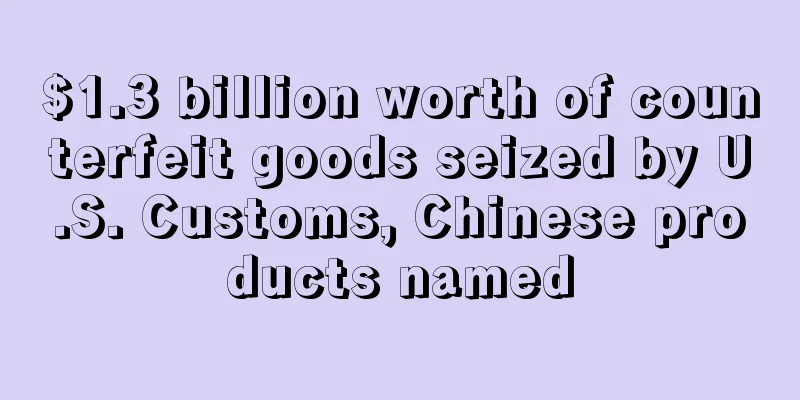$1.3 billion worth of counterfeit goods seized by U.S. Customs, Chinese products named

|
U.S. Customs seizes $1.3 billion in counterfeit goods in 2020
Data shows that in fiscal year 2020, the U.S. Customs seized a total of 26,503 batches of goods, and the total value of these counterfeit goods was as high as US$1.3 billion, which is a terrifying number.
Recently, the U.S. Customs and Border Protection ( CBP) conducted inspections on specific goods, and the focus of the inspection mainly included goods imported specifically from China and Hong Kong, China. According to U.S. Customs officials, this activity was mainly to intercept counterfeit medical equipment and supplies. After inspecting nearly a thousand batches of goods, 25 batches of goods were seized, with a total value of more than $500,000.
Among them, the counterfeit goods mainly include 469 well-known brand sportswear, 163 luxury handbags, sunglasses and electronic products, as well as 25 adulterated drugs and animal vaccines. These goods mainly come from China, Laos, South Korea and other places.
In fact, the rapid development of e-commerce has enabled consumers to easily purchase millions of products through online stores, but this convenient shopping method has also provided a sales channel for counterfeit and pirated goods, which are mainly sold in underground stores and third-party e-commerce websites.
However, many platforms have taken various measures to crack down on sellers who sell counterfeit goods, especially Amazon, which has continuously launched new measures to crack down on counterfeit sellers, but counterfeit goods cannot be eliminated. For this reason, the US Congress also issued a "Comment on the Notorious Market for Counterfeiting and Piracy" and ordered a strict investigation of counterfeit goods on platforms such as Amazon.
Counterfeit goods cost U.S. consumers $100 billion a year
Relevant data shows that the United States loses nearly 100 billion US dollars every year due to counterfeit goods, which is one of the reasons why the U.S. Customs strictly investigates and cracks down on counterfeit goods. These counterfeit goods are mainly popular products, such as smartphones and related accessories, electronic products, clothing, cosmetics, high-end luxury goods and medical supplies.
Sellers may not only face the seizure and surrender of goods, but may also be sued by major brands for product infringement, etc. To this end, the U.S. Customs has also established an education program to educate consumers on the truth behind counterfeit goods and to raise awareness of the consequences and dangers associated with purchasing counterfeit and pirated goods.
Cross-border sellers also need to pay attention. As the US Customs cracks down on counterfeit goods, such actions will be carried out from time to time, and various platforms are gradually starting to clear mines. Sellers must pay attention to it, eliminate counterfeit goods, and avoid skirting the rules in order to win the real market. U.S. Customs China Counterfeit goods |
Recommend
What is AdPlexity? AdPlexity Review, Features
Adplexity is a competitive intelligence tool that ...
I lost 1 million yuan on Amazon! Seller: I will definitely make money in 2023
Don’t worry, you are not the only one doing year-...
What is Seller Interactive? Seller Interactive Review, Features
<span data-docs-delta="[[20,{"gallery"...
Top 10 Russian search products in 2021 released
Avito is the most popular classified advertising ...
Selling over 4 million US dollars! TikTok Southeast Asia has another hit product
With the turbulent e-commerce era, major sellers ...
To survive in the cracks, cross-border companies choose to move into "old, dilapidated and small" houses
Anyone who has been a boss knows that it is reall...
What is Cresco? Cresco Review, Features
Cresco is available through Platform as a Service ...
What is 通发する蔵? 通盈する蔵Review, Features
Tsumasu Ruzo provides a sense of security and emo...
The US second-hand market value reaches 35 billion US dollars! Poshmark has a poor outlook
Poshmark has beaten analysts’ revenue expectation...
The Port of Long Beach handled a record number of containers in March, and port congestion decreased
The congestion problem at the Port of Long Beach ...
What is Dream Business Service? Dream Business Service Review, Features
Dream Business Service is a Sino-US enterprise-lev...
There is new progress in Huadong’s preparation for overseas listing!
The capitalization track is booming, and many cro...
"Mom's style" becomes a trendy item! A 10-year-old clothing factory "turns around" in three months by making SHEIN
As the saying goes, clothing comes first among th...
Etsy helps sellers boost sales on Valentine's Day! These products are expected to be a big hit
Valentine's Day is getting closer and closer,...
What is Tibi? Tibi Review, Features
<span data-docs-delta="[[20,{"gallery"...









